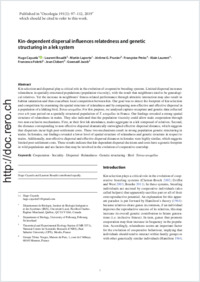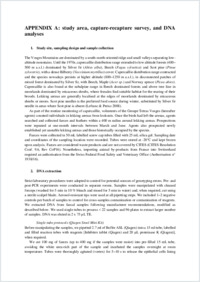Kin-dependent dispersal influences relatedness and genetic structuring in a lek system
- Cayuela, Hugo Département de Biologie, Institut de Biologie Intégrative et des Systèmes (IBIS) Université Laval, Pavillon Charles-Eugène-Marchand, Québec, Canada
- Boualit, Laurent Department of Biology, University of Fribourg, Switzerland
- Laporte, Martin Département de Biologie, Institut de Biologie Intégrative et des Systèmes (IBIS) Université Laval, Pavillon Charles-Eugène-Marchand, Québec, Canada
- Prunier, Jérôme G. Theoretical and Experimental Ecology Station (UMR 5371), National Centre for Scientific Research (CNRS)Paul Sabatier University (UPS)Moulis, France
- Preiss, Françoise Groupe Tétras Vosges, Munster, France
- Laurent, Alain Groupe Tétras Vosges, Munster, France
- Foletti, Francesco Department of Biology, University of Fribourg, Switzerland
- Clobert, Jean Theoretical and Experimental Ecology Station (UMR 5371), National Centre for Scientific Research (CNRS)Paul Sabatier University (UPS)Moulis, France
- Jacob, Gwenaël Department of Biology, University of Fribourg, Switzerland
-
01.09.2019
Published in:
- Oecologia. - 2019, vol. 191, no. 1, p. 97–112
English
Kin selection and dispersal play a critical role in the evolution of cooperative breeding systems. Limited dispersal increases relatedness in spatially structured populations (population viscosity), with the result that neighbours tend to be genealogical relatives. Yet the increase in neighbours’ fitness-related performance through altruistic interaction may also result in habitat saturation and thus exacerbate local competition between kin. Our goal was to detect the footprint of kin selection and competition by examining the spatial structure of relatedness and by comparing non-effective and effective dispersal in a population of a lekking bird, Tetrao urogallus. For this purpose, we analysed capture–recapture and genetic data collected over a 6-year period on a spatially structured population of T. urogallus in France. Our findings revealed a strong spatial structure of relatedness in males. They also indicated that the population viscosity could allow male cooperation through two non-exclusive mechanisms. First, at their first lek attendance, males aggregate in a lek composed of relatives. Second, the distance corresponding to non-effective dispersal dramatically outweighed effective dispersal distance, which suggests that dispersers incur high post-settlement costs. These two mechanisms result in strong population genetic structuring in males. In females, our findings revealed a lower level of spatial structure of relatedness and genetic structure in respect to males. Additionally, non-effective dispersal and effective dispersal distances in females were highly similar, which suggests limited post- settlement costs. These results indicate that kin-dependent dispersal decisions and costs have a genetic footprint in wild populations and are factors that may be involved in the evolution of cooperative courtship.
- Faculty
- Faculté des sciences et de médecine
- Department
- Département de Biologie
- Language
-
- English
- Classification
- Biological sciences
- License
- License undefined
- Identifiers
-
- RERO DOC 327367
- DOI 10.1007/s00442-019-04484-z
- Persistent URL
- https://folia.unifr.ch/unifr/documents/308026
Other files
Statistics
Document views: 74
File downloads:
- jac_kdd.pdf: 139
- jac_kdd_sm.pdf: 104

